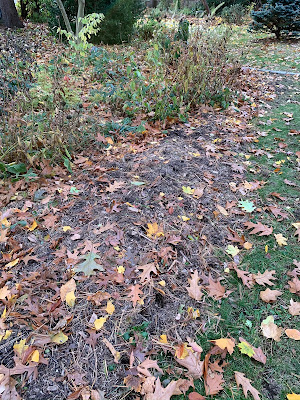 |
| Lush and green in 2013--but with pesticide spraying |
I started the spraying back in the 1990s when I noticed pinpoint white speckles on the leaves of Japanese pieris (Pieris japonica), an elegant early-blooming evergreen shrub.
 |
| Marked leaves of Japanese pieris |
A technician from Lueders Environmental diagnosed pieris lacebug, a tiny sap-sucking insect that originated in Japan and has spread around the gardening world. Decades of spraying kept the pieris leaves clean. When we stopped the spraying, the lacebugs came back. New foliage emerging the next spring was shiny and unmarked, but by the end of the growing season, all the pieris foliage was speckled again.
After we stopped spraying our many boxwoods (Buxus sempervirens) for psyllids, their leaves too weren’t as well formed and healthy-looking as they’d been with chemical protection.
 |
| Psyllids have inscribed and curled these boxwood leaves |
I’d thought the nonnative boxwood shrubs were problem-free. That was a false impression created by pesticide spraying.
I’d agreed to use pesticides thinking I was protecting my trees and shrubs. Later we added dormant oil spray for hemlock woolly adelgid and Spinosad, a naturally derived insecticide, for winter moth. Those were nonnative insects with no local predators, I argued. I feared that they’d decimate my yard if they weren’t stopped.
 |
| A bleak scene: hemlocks dying from woolly adelgid infestation |
Around 2011 I started to get uncomfortable with this approach. Yes, I was targeting problem insects with each pesticide, and the chemicals had each been chosen for least toxicity for humans, mammals and birds. But my newfound concern for the native insects in the yard shifted the frame. I came to realize that no matter how carefully they were applied, these pesticides would always cause collateral damage, killing native insect bystanders that could be leaf-eaters, pollinators, or beneficial insect predators that I wanted to foster and encourage.
 |
| I didn't want to kill beneficial insects such as this ladybug, seen here eating an aphid |
After gradually cutting down on spraying, in 2016 I finally decided it was time to make a total break with garden pesticides. Regretfully, we had our hemlocks cut down so we wouldn’t need to spray for hemlock woolly adelgid, a particularly pernicious nonnative pest.
 |
| The fluffy white balls along these hemlock twigs are woolly adelgid egg cases |
Probably no one but me noticed when, without pesticide treatment, the leaf damage reappeared on the pieris and boxwood leaves. The leaves didn’t change color or drop off. The subtle damage just made me worry that worse was to come.
Instead, this year the infestations seem less comprehensive. That could mean that without pesticides, the garden ecosystem is rebounding. In a healthy ecosystem, there’s a balance between leaf eaters and their predators.
 |
| Dragonfly on St. John's wort: one of the predators I want to welcome |
There’s also plenty of redundancy, so that if one population of insects has a hard year, there are others to fill their role in the community. I’d love to think that’s the ecosystem we’re building here.



















